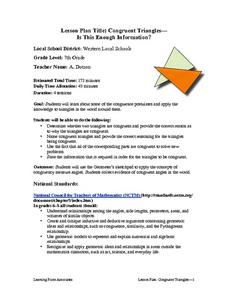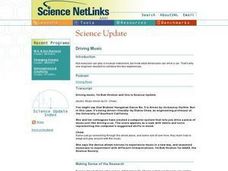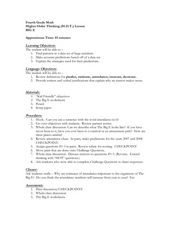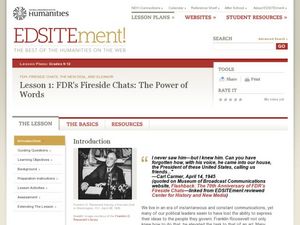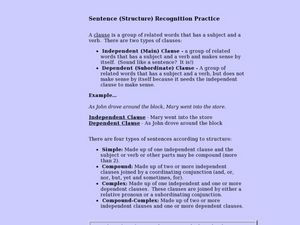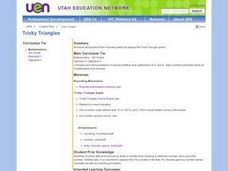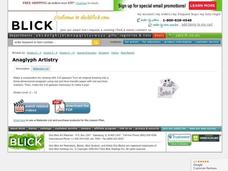Curated OER
Social Studies: Adinkra Printing
First graders demonstrate a sense of artistic composition by creating shapes and symbols in the pattern of African Adinkra printing. They use glue to create a raised design and then print it on colored paper. Students use symbols from...
Curated OER
Congruent Trianges - Is This Enough Information?
Seventh graders determine whether two triangles are congruent and provide an explanation to why they are not. They apply concepts of measurement of angles and collect evidence of congruent angles in the world.
Curated OER
Driving Music
Students experience both playing a musical instrument and driving a car. The two experiences tied together by one engineer. The score appears as a road, with twists and turns representing the composer's suggested shifts in mood. This...
Curated OER
A Plane Old Time
Fourth graders become familiar with a chart and use the information to create a flight plan. In this flight plan lesson plan, 4th graders access background knowledge of the role of flight controllers and the number concepts they...
National Endowment for the Humanities
Anne Frank: Writer
Students explore the writings of Anne Frank. They discuss how Anne did or did not change during her two years in the Secret Annex. Students take a stand on how much Anne has in common with contemporary young people.
Curated OER
Higher Order Thinking (H.O.T.) Lesson - BIG E
Fourth graders work with patterns while using large numbers. In this patterning lesson, 4th graders go over the definitions of the words: predict, estimate, attendance, increase, and decrease. They complete worksheets in which they track...
Curated OER
FDR's Fireside Chats: The Power of Words
Learners examine Franklin D. Roosevelt's Fireside Chats. In this presidential history lesson, students listen to the radio broadcasts of select FDR Fireside Chats. Learners analyze the effectiveness of his messages to the public as well...
Curated OER
Sentence (Structure) Recognition Practice
In this sentence clauses worksheet, sixth and seventh graders read ten sentences and write down whether the sentence is: simple, compound, complex or compound-complex.
Curated OER
LESSON 4: Looks Like Respect, Sounds Like Respect, Feels Like (K-2)
Students show competency in Art objectives by designing and creating props (glasses-looks, ears-headband, and [feel] texture board) for each of the given senses.
Curated OER
Strip-Teasers: A Collaborative Writing activity
Young writers engage in a fun writing activity. They write three different sentences on three strips of paper. Then they get into groups of three, and take a look at all nine sentences that have been written. Their task is to write a...
Curated OER
ENDOWING SUPPORT ELEMENTS
Students demonstrate how an actor might engage sensate reaction using 3 sets of stage props. They imagine and use as many sense reactions as they can to make the props become endowed with a reality. They use one table and chair to...
Curated OER
What are Rocks and Minerals? How can they help us?
Sixth graders investigate the difference between rocks and minerals. They name the three kinds of rocks (sedimentary, igneous, and metamorphic) and know the differences between them.
Curated OER
Cooking Super Star Meals with Kids
Students explore the benefits of allowing and providing specifically designed age-appropriate cooking experiences for young children. They "cook" a variety of creative, healthy dishes designed for 3-5 year-olds to make and to help them...
Curated OER
Fish: General Information and a Dissection
Pupils, after taking a "fish quiz" in class, assess the different parts of a fish and their purposes. They dissect two yellow perch fish in class. In addition, they discuss the different parts of the fish as they dissect their organs.
Curated OER
A Tree Is More than a Street Name
Eighth graders discuss the role of trees as one of the most important natural resources. In groups, they examine how the forests nearby helped to shape their urban city. Using the internet, they research the use of the forest in early...
Curated OER
Rolling For Value
Students participate in a activity to comprehend the concept of probability while rolling dice. They recognize patterns while making observations and recording the data for each roll. Students also review place values while playing a...
Curated OER
Making Sense of Density
Students identify the concepts of density, mass, and volume that define the property of a substance. They also determine that the properties of materials, such as, density and volume, can be compared and measured by using rulers,...
Curated OER
Tricky Triangles
Third graders engage in a instructional activity that is concerned with the playing of a Trick Triangle Game while focusing upon developing skills of addition, subtraction, multiplication, and division. They play the game and practice...
Curated OER
Introduction To Calculus
Students engage in a activity that is about an introduction to the course of calculus. They practice some of the basic concepts and solve some problems applying different principals of calculus. The teacher uses the sample problems...
Curated OER
Pretend Memoirs
Elementary schoolers explore the concept of a memoir. The teacher tells a story from his/her childhood as an example of what a memoir is; a written account of one's past. The kids are asked to pretend that they are now adults, and are...
Santa Monica-Malibu Unified School District
Parts of Speech Adverbs: Building Blocks of Grammar
What is the difference between an adjective and an adverb? Encourages scholars to explore the answer to this question while building a foundation of the English language. The instructional activity comes complete with an attention...
Mathematics Assessment Project
Matching Situations, Graphs and Linear Equations
What do guitars, candles, and helicopters have in common? They're all in this resource. Learners complete an assessment task to determine the amount of profit made in a guitar class based on given information regarding variable...
Illustrative Mathematics
Molly's Run
A simple lesson with a lot of support behind it. Your learners will find out how long it takes Molly to run a mile by choosing their solution method. The activity can be used as a lesson or as an independent assignment. Preface with...
Mathematics Assessment Project
Modeling Motion: Rolling Cups
Connect the size of a rolling cup to the size of circle it makes. Pupils view videos of cups of different sizes rolling in a circle. Using the videos and additional data, they attempt to determine a relationship between cup...

